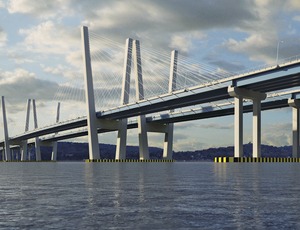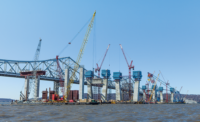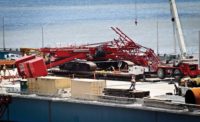
Fourteen years ago, the New York State Thruway Authority proposed a plan to replace the then-44-year-old Tappan Zee Bridge, a 6,014-ft-long, seven-lane crossing carrying Interstates 87 and 287 over the Hudson River. That proposal followed decades of Band-Aid work to keep the bridge viable, including a $20.8-million panel rehabilitation in 1997 (ENR 6/9/97 p. 19). The cost of a replacement, the agency estimated, would be $4 billion. The time line was forecast for 10 years.
Two years later, in 2002, the environmental review process began. In 2011, it was still ongoing. But then came a perfect alignment of key events, says Thomas Madison Jr., the authority's executive director, that allowed New York state agencies to complete a new a permitting process, hire Tappan Zee Constructors and start construction in less than three years. "The great thing is that we didn't cut any corners," he adds.
In October of that year, the White House designated the bridge as a so-called Dashboard project—one of the initial projects of "national or regional significance" that would undergo an expedited review based on the President's Council on Jobs and Competitiveness' recommendations for improving the federal permitting and review process.
Two months later, the New York state Legislature passed a law allowing for design-build delivery of certain infrastructure projects, including the Tappan Zee Bridge. Less than a year later, the state applied for a Transportation Infrastructure Finance and Innovation Act (TIFIA) loan of $1.5 billion and reached a project labor agreement with 14 unions.
Thanks to Dashboard, state agencies were able to restart the environmental impact statement process and finish it in 11 months, as opposed to about seven years, says Madison. The federal and state environmental review processes were completed jointly in September 2012. A steering committee of top-level officials met weekly, says Madison. "It was great to have the Federal Highway Administration right there when issues arose," he says.
Agents of every other executive-branch stakeholder also were there, adds John Porcari, then-deputy secretary of the U.S. Dept. of Transportation and now with Parsons Brinckerhoff. They formed a "rapid response" team that front-loaded involvement of all stakeholders, including the public. The team ran the state and federal environmental reviews simultaneously, along with the TIFIA application and the Army Corps of Engineers' permit processes, Porcari says.
The experience will inform future efforts to reform the federal and state procedures, say Porcari and Madison, respectively. "It is hard work and requires organizational cultural changes," adds Porcari.
The key was political will, largely on the part of Gov. Andrew Cuomo (D). Madison and Porcari credit Cuomo with pushing for the Dashboard designation and the design-build law. Political will was also crucial at the federal level. "This is a bipartisan effort for process reform," says Porcari





Post a comment to this article
Report Abusive Comment